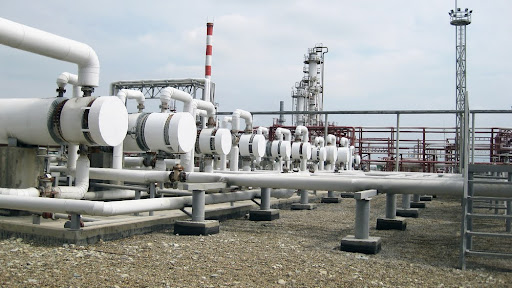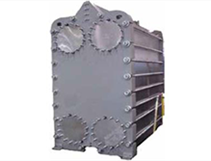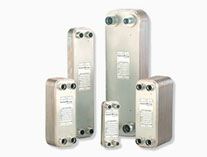
Plate fin heat exchangers are vital components for enhancing thermal performance in diverse industries. These exchangers utilize a sequence of parallel plates and fins to maximise floor region for heat switch. The compact design permits them to effectively cope with excessive-temperature and excessive-pressure fluids, making them best for applications in sectors like aerospace, electricity technology, and HVAC. The precise association of plates and fins increases the thermal conductivity and allows a greater uniform temperature distribution across the gadget. With their flexibility in layout and alertness, plate fin heat exchangers are regularly used where area constraints and excessive heat switch performance are important.

The Role of Plate Fin Heat Exchangers in Modern Industries
Plate fin warmth exchangers play a good sized function in numerous industries, imparting an top of the line answer for thermal control. In the automotive enterprise, these heat exchangers are used to cool engines and other components, ensuring longevity and performance. In the aerospace area, they’re applied in plane systems to regulate temperature, especially in turbines and warmth-touchy areas. The versatility of plate fin warmth exchangers in dealing with quite a number fluids, from gases to drinks, makes them important in industries that demand each excessive performance and durability.
Heat Transfer Efficiency of Plate Fin Heat Exchangers
One of the important thing blessings of plate fin warmth exchangers is their capacity to offer superior warmness switch performance in comparison to standard warmth exchangers. The massive floor place furnished with the aid of the stacked plates and fins allows for more heat trade between the fluids. This expanded floor area results in quicker thermal exchange and better normal performance in dealing with temperature extremes. The combination of plate fins and fluid dynamics optimizes the heat switch process, making sure greater efficient cooling or heating even as minimizing electricity loss.
Material Selection for Plate Fin Heat Exchangers
Choosing the right substances for plate fin warmness exchangers is important to make sure both durability and efficient overall performance. Common substances encompass aluminum, stainless-steel, and copper, every offering specific advantages. Aluminum, with its light-weight houses, is often used in aerospace applications, while stainless steel offers strength and corrosion resistance to be used in greater competitive environments. Copper, recognized for its first-rate thermal conductivity, is typically selected for situations that call for fast heat transfer. The choice of materials depends on elements just like the running temperature, strain, and the kind of fluids involved.
Customization in Plate Fin Heat Exchangers
Customization is a critical element in the design of plate fin warmth exchangers. Engineers often adjust the size, form, and configuration of the plates and fins to fulfill specific operational wishes. Custom designs make sure that the warmth exchangers are optimized for particular packages, whether or not it’s a compact unit for a small system or a bigger unit for industrial methods. This flexibility in design lets in plate fin warmth exchangers to be enormously adaptable to numerous working situations, making them necessary in industries wherein space, performance, and overall performance are paramount.
The Impact of Plate Fin Heat Exchangers on Energy Efficiency
Energy efficiency is a top precedence in many industries, and plate fin warmness exchangers contribute considerably to reaching this goal. Their high warmth transfer fee approach that much less electricity is needed to achieve the same thermal impact, decreasing operational fees. In power-extensive industries like energy generation and oil refineries, this performance can lead to big financial savings. By enhancing the general heat alternate manner, plate fin warmth exchangers now not simplest beautify machine performance but also assist in lowering environmental effect via minimizing energy waste.
-flanged-heads8627737de6046fa4b688ff0000f8d730.jpg?sfvrsn=9f231ce9_6)
Plate Fin Heat Exchangers in Aerospace Applications
In the aerospace enterprise, the want for lightweight and green thermal systems is essential. Plate fin warmness exchangers are a favored desire in this sector due to their potential to supply high warmness switch in a compact and lightweight form. They are usually utilized in plane to cool engines, avionics, and hydraulic structures. The capability to function in severe situations, consisting of high pressures and temperatures, makes plate fin warmth exchangers an vital part of current aircraft layout. Their reliability and performance contribute to the safety and durability of aerospace structures.
Plate Fin Heat Exchangers in Automotive Cooling Systems
Automotive engines generate a large amount of warmth, which must be dissipated efficiently to hold premier overall performance. Plate fin heat exchangers are broadly utilized in automobile cooling structures, especially in excessive-overall performance motors. Their potential to handle high coolant flows while keeping a compact length makes them best for use in engines, radiators, and intercoolers. These warmness exchangers help modify the engine’s temperature, preventing overheating and making sure clean operation below stressful conditions.
Plate Fin Heat Exchanger Maintenance and Longevity
Proper maintenance is fundamental to making sure the long-time period performance of plate fin warmth exchangers. Regular cleansing and inspection of the fins and plates can assist save you blockages and ensure maximum warmth switch efficiency. Additionally, addressing problems like corrosion or wear in a well timed way can amplify the lifespan of those structures. With the right care, plate fin heat exchangers can offer reliable performance for decades, making them a value-effective investment for industries that require sustained heat management answers.
Plate Fin Heat Exchangers vs. Other Heat Transfer Products
When as compared to other forms of heat exchangers, plate fin heat exchangers provide awesome advantages. They are generally greater compact and efficient in phrases of warmth transfer, which makes them perfect for applications wherein area and performance are key considerations. While shell and tube warmth exchangers are regularly utilized in large systems, plate fin warmness exchangers excel in smaller, greater problematic designs. The flexibility in customization and the excessive surface area provided by way of the plates and fins make them superior for programs requiring tight temperature manipulate and most power performance.
Challenges in Plate Fin Heat Exchanger Design and Operation
Despite their many blessings, plate fin heat exchangers come with positive demanding situations in layout and operation. One of the number one challenges is managing the capability for clogging or fouling, specially while running with fluids that contain particulate count number or corrosive elements. This can lessen the efficiency of heat transfer and can require extra common renovation. Additionally, the complexity of designing those exchangers to address precise temperature and strain necessities can be a venture, requiring particular engineering and exquisite substances.

Future of Plate Fin Heat Exchangers and Heat Transfer Products
The future of plate fin heat exchangers seems promising, with ongoing advancements in materials and design era. Innovations in nanotechnology and superior materials are predicted to improve heat transfer efficiency even in addition. Additionally, as industries maintain to cognizance on sustainability and electricity performance, the call for for excessive-overall performance warmness transfer products like plate fin warmth exchangers will likely grow. Continued research and improvement will cause even more compact, long lasting, and efficient structures that may take care of greater difficult thermal management needs in a extensive variety of industries.
Conclusion
In conclusion, plate fin heat exchangers are imperative to optimizing warmness switch in various industries, providing awesome efficiency and performance in annoying environments. Whether utilized in aerospace, automobile, or power industries, those heat transfer products play a essential function in retaining system reliability and power performance. The versatility, compactness, and customization alternatives to be had with plate fin heat exchangers lead them to an important preference for corporations in search of effective thermal control solutions. As the call for for strength-efficient and sustainable technologies grows, plate fin warmness exchangers will keep to adapt, offering stronger performance and contributing to greater efficient heat switch across more than one industries.